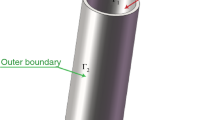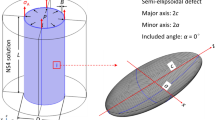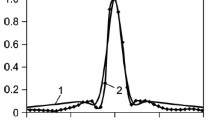Abstract
Industrial pipelines work in high temperature and are corrosive, and this causes corrosion and shedding of the inner walls. Therefore, it is a realistic engineering problem to detect the defect information of pipeline accurately. In the paper, according to the characteristics of pipeline and heat conduction theory, the temperature field is equivalent to a composite model. Utilizing the three-dimensional heat conduction equation, the heat dissipation temperature field model of no-defects pipeline is established. Taking the medium temperature as the boundary condition, the model is solved by variables separation method and Bessel function. Secondly, based on the principle of microelement integration and finite element, considering the uncertainty of the defect boundary, the boundary information is expressed by the geometric variable factors of virtual heat source. And heat source temperature field model is obtained. Then, using the defect radius as the variable, the boundary function of the defect is established. Thirdly, considering the temperature field function and the maximum allowable pressure of the pipeline, the effective temperature evaluation model of pipeline defects is constructed. Finally, using the experiments and the Simulation of Software COMSOL, the feasibility of the pipeline models is verified. The relationship between the defect boundary and the temperature can be analyzed by mathematical methods. Internal defects in pipes are quantitatively analyzed and evaluated. This provides a theoretical basis for ensuring the quality and operation of the pipeline.



















Similar content being viewed by others
References
Rouse S, Hayes P, Davies IM, Wilding TA. Offshore pipeline decommissioning: scale and context. Mar Pollut Bull. 2018;4(129):241–4. https://doi.org/10.1016/j.marpolbul.2018.02.041.
Sfarra S, Regi M, Tortora M, et al. A multi-technique nondestructive approach for characterizing the state of conservation of ancient bookbindings. J Therm Anal Calorim. 2018;132:1367–87. https://doi.org/10.1007/s10973-018-6997-1.
Ma YD, Yuan RB, He BH, Jiang HH, Liu Z, Huang YY, Tang J, Luo J, Zhou B, Qian JB, Zhu Y, Chen L. Temperature variation and distribution in tobacco casing cylinder based on infrared thermal imaging detection. Innov Tech and Appl of Model Ident Control. 2018. https://doi.org/10.1007/978-981-10-7212-3_25.
Dalla PM, Gaule D, Pimazzoni A, et al. Thermal analysis and high heat flux testing of unidirectional carbon–carbon composite for infrared imaging diagnostic. J Therm Anal Calorim. 2018;143:143–55. https://doi.org/10.1007/s10973-018-7430-5.
Gui XH, Song XG, Nie BS. Thermal Analysis of void cavity for heat pipe receiver under microgravity. J Therm Sci. 2017;26:138–43. https://doi.org/10.1007/s11630-017-0922-y.
Chaing MT, Huang CH. A transient three-dimensional inverse geometry problem in estimating the space and time-dependent irregular boundary shapes. Int J Heat Mass Transf. 2008;51:5238–46. https://doi.org/10.1016/j.ijheatmasstransfer.2008.03.019.
Zhou JH, Zhang YW, Chen JK, et al. Inverse estimation of surface heating condition in a three-dimensional object using conjugate gradient method. Int J Therm Sci. 2010;53:2643–54. https://doi.org/10.1016/j.ijheatmasstransfer.2010.02.048.
Zhang FL, Yuan ZH, Dong S, Kang J. The study of the cavity inside heavy forgings based on the temperature field detection model. Int J Adv Manuf Technol. 2018;99:595–611. https://doi.org/10.1007/s00170-018-2442-7.
Chen CK, Su CR. Inverse estimation for temperatures of outer surface and geometry of inner surface of furnace with two layer walls. Energy Convers Manag. 2008;49(2):301–10. https://doi.org/10.1016/j.enconman.2007.06.010.
Gloaguen D, Berchi T, Girard E, Guillén R. Examination of residual stresses and texture in zirconium alloy cladding tubes after a large plastic deformation: experimental and numerical study. J Nucl Mater. 2017;374(1):138–46. https://doi.org/10.1016/j.jnucmat.2007.07.017.
Beitone C, Balandraud X, Delpueyo D, Grédiacab M. Heat source reconstruction from noisy temperature fields using a gradient anisotropic diffusion filter. Infrared Phys Technol. 2017;80:27–37. https://doi.org/10.1016/j.infrared.2016.11.003.
Zhang B, Zhang BJ, Zhang D, Zhang Y. Research process of nondestructive testing pitting corrosion in metal material. J Hebei Univ Sci Thechnol. 2017;38(6):508–14.
Feng LC, Tao N, Xu C, et al. Phase locked thermography and its application in NDT. Infrared Laser Eng. 2010;39(6):1120–3.
Tao N, Zeng Z, Feng LH, et al. Finite element simulation of surface recognition based on pulse infrared thermography. Chin Laser. 2012;39(11):1108–13.
Mei L, Wu LD, Wang YW, et al. A new method of infrared nondestructive testing defect based on genetic algorithm. J Opt. 2002;22(12):1452–6.
Wang D, Shi J. Study on infrared differential thermal non-destructive testing technology of the permeability of hot mix asphalt pavements. IOP Conf Ser Earth Environ Sci. 2017;69(1):012109.
Lee JH, Kim SP, Jeon RW, Lee GH. Numerical study on the thermal fatigue of cryogenic vacuum insulated pipe. Appl Phys Sys Sci Comput. 2017. https://doi.org/10.1007/978-3-319-53934-8_33.
Brandaleze E, Bazán V, Orozco I, et al. Application of thermal analysis to the rhenium recovery process from copper and molybdenum sulphides minerals. J Therm Anal Calorim. 2018;133:435. https://doi.org/10.1007/s10973-018-7104-3.
Valentin A, Jadvyga K, Edmundas S, Rimvydas S, Renata B. Investigation of ageing of alumina cement-based mixtures using thermal analysis and calorimetry. J Therm Anal Calorim. 2017;130:35–44. https://doi.org/10.1007/s10973-017-6201-z.
Barat K, Ghosh M, Sivaprasad S, Kar SK, Tarafder S. High-temperature low-cycle fatigue behavior in HAYNES 282: influence of initial microstructure. Metall Mater Trans A. 2018;49:5211. https://doi.org/10.1007/s11661-018-4760-7.
Zhang YC, Zhang LQ, Fu XB, et al. Analyses of interior temperature field distribution for hot axial forgings with void. China Mech Eng. 2015;26(15):2672–5. https://doi.org/10.3969/j.issn.1004-132X.2015.19.020.
Zhao J, Dong H, Wei L, et al. Research on heat transfer characteristic of waxy crude oil after oil pipeline shutdown. J Therm Anal Calorim. 2017;129:487–508. https://doi.org/10.1007/s10973-017-6121-y.
Fan CL. Geometric heat conduction inverse problem method and Application. 1st ed. Science press 2015;10:123–140.
Wang LL, Zhang H, Qi HB, Li D. Local stress analysis of pipes with ellipsoidal defect at high temperature. J Petro U. 2018. https://doi.org/10.3969/j.issn.1006-396X.2018.01.095.
Li Z, Wu JX. Fatigue life analysis based on the temperature field of flat die. J For Eng. 2016;1(2):96–100. https://doi.org/10.13360/j.issn.2096-359.2016.02.01.
Zhou S, Zhang YC, Fu XB. Inner wall running state monitoring for the main pipe of nuclear power. Sci China Technol Sci. 2013;56(10):2606–14. https://doi.org/10.1007/s11431-013-5332-0.
Zhou HX. The analysis of the ultimate bearing capacity of dent pipeline. SWPU. 2016.
Acknowledgements
This study is supported by National Natural Science Foundation of China (No: 51505381).
Author information
Authors and Affiliations
Corresponding author
Additional information
Publisher's Note
Springer Nature remains neutral with regard to jurisdictional claims in published maps and institutional affiliations.
Rights and permissions
About this article
Cite this article
Zhang, F., Yuan, Z. The detection and evaluation for the internal defection in industrial pipeline based on the virtual heat source temperature field. J Therm Anal Calorim 137, 949–964 (2019). https://doi.org/10.1007/s10973-018-07988-7
Received:
Accepted:
Published:
Issue Date:
DOI: https://doi.org/10.1007/s10973-018-07988-7




